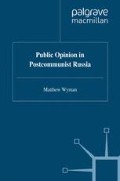Abstract
Up to now, this study has concentrated on trends in public opinion. Although from time to time reference has been made to the views of different groups within Russia, the stress has been on similarity of attitudes rather than difference. Yet this is a country of great variation: across 5000 miles and 11 time zones; between more than a hundred different ethnic groups; between generations with wholly different life experiences; between people’s lives in rural areas and in Russia’s biggest cities; between the privileged and the deprived. So what sense is it possible to make of the differences in attitude that exist in Russian society?
Access this chapter
Tax calculation will be finalised at checkout
Purchases are for personal use only
Preview
Unable to display preview. Download preview PDF.
Notes
See in particular the volume edited by James R. Millar, Politics, Work and Daily Life in the USSR: A Survey of Former Soviet Citizens (Cambridge: Cambridge University Press, 1987), in particular the chapter by Donna Bahry, ‘Politics, Generations and Change in the USSR’.
In particular Ada W. Finifter and Ellen Mickiewicz, ‘Redefining the Political System of the USSR: Mass Support for Political Change’, American Political Science Review, 86, 4 (1992), pp. 857–74.
For example, most of the contributors to Arthur H. Miller, William M. Reisinger and Vicki L. Hesli (eds), Public Opinion and Regime Change: The New Politics of Post-Soviet Societies (Boulder CO: Westview Press, 1993).
See, however, Vicki L. Hesli and Arthur H. Miller, ‘The Gender Base of Institutional Support in Lithuania, Ukraine and Russia’, Europe-Asia Studies 45, 3 (1993), pp. 505–32. Of course the major exception to this is research into differences between the attitudes of the more important nationalities within the former USSR. Identifying such differences, however, is of limited help in understanding contemporary Russian politics.
For a useful breakdown of regional voting patterns see Aleksandr Sobyanin, Eduard Gel’man and Oleg Kayunov, ‘Politicheskii klimat v Rossii v 1991–1993 gg.’, Mirovaya ekonomika i mezhdunarodnye otnosheniya, 9 (1993), pp. 20–32.
Author information
Authors and Affiliations
Copyright information
© 1997 Matthew Wyman
About this chapter
Cite this chapter
Wyman, M. (1997). One Nation?. In: Public Opinion in Postcommunist Russia. Studies in Russian and East European History and Society. Palgrave Macmillan, London. https://doi.org/10.1057/9780230373631_8
Download citation
DOI: https://doi.org/10.1057/9780230373631_8
Publisher Name: Palgrave Macmillan, London
Print ISBN: 978-0-333-64420-1
Online ISBN: 978-0-230-37363-1
eBook Packages: Palgrave Political & Intern. Studies CollectionPolitical Science and International Studies (R0)

